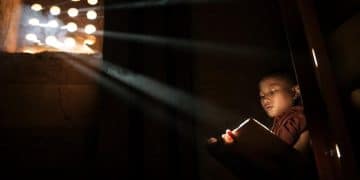Beyond the Script: Theater Criticism’s Improvised Future

Beyond the Script explores how improvisation and audience interaction are revolutionizing theater criticism, fostering a more dynamic and participatory relationship between performers, spectators, and critics alike.
The landscape of theater is changing, and so is the way we critique it. Beyond the Script: How Improvisation and Audience Interaction Are Changing Theater Criticism delves into the exciting realm where spontaneity and audience participation redefine the theatrical experience and challenge traditional critical approaches.
The Rise of Improv and Interactive Theater
Improvisational theater and performances that actively involve the audience are no longer niche forms of entertainment. They’re becoming increasingly prevalent, demanding a new perspective from theater critics.
This shift requires critics to move beyond evaluating a fixed script and consider the unpredictable energy of live, interactive performances.
The Appeal of the Unscripted
Improv’s appeal lies in its spontaneity. Each performance is unique, driven by the creativity of the performers and the suggestions of the audience. This creates a dynamic and unpredictable experience that can be incredibly engaging.
Interactive Theater: Breaking the Fourth Wall
Interactive theater takes audience engagement a step further, blurring the lines between performer and spectator. Audience members might make choices that affect the plot, participate in scenes, or even become characters themselves.
- The rise of immersive theater experiences.
- The increasing popularity of participatory performances.
- How technology enhances audience interaction.
These trends are exciting, but they also present challenges for traditional theater criticism. How do you critique something that is constantly evolving and inherently collaborative?
Traditional Criticism vs. the Improvised
Traditional theater criticism typically focuses on analyzing the script, direction, acting, and design of a production. But what happens when there is no fixed script, and the audience is actively shaping the performance?
Critics must adapt their approaches to consider the unique elements of improv and interactive theater.

Limitations of Script-Based Analysis
Relying solely on script-based analysis can miss the point of improv and interactive theater. These forms emphasize spontaneity, collaboration, and audience engagement, aspects that are not captured in a written script.
The Need for New Critical Frameworks
Critics need to develop new frameworks that account for these unique elements. This might involve focusing on the performers’ ability to react and adapt, the effectiveness of audience interaction, and the overall energy and atmosphere of the performance.
Traditional theater criticism often involves evaluating the director’s interpretation of the script, the actors’ portrayal of their characters, and the overall coherence and impact of the production.
When applied to improvisational theater, these criteria become less relevant. There is no director in the traditional sense, and the actors are not portraying pre-defined characters. Instead, they are creating characters and scenes on the fly, reacting to each other and to the audience.
Evaluating Spontaneity and Collaboration
One of the key challenges for critics is evaluating spontaneity. How do you determine whether an improvised scene is successful? Is it based on the cleverness of the performers, the originality of their ideas, or the overall impact of the scene?
Collaboration is another important factor to consider. Improv is inherently a collaborative art form, with performers relying on each other to build scenes and create stories.
Assessing the Performers’ Chemistry
Critics need to assess the chemistry between the performers. Are they able to listen to each other, build on each other’s ideas, and create a cohesive performance?
Measuring Audience Engagement
Another key aspect of improv and interactive theater is audience engagement. How effectively does the performance involve the audience? Are audience members actively participating and contributing to the performance?
- The use of audience suggestions in improv.
- The impact of audience participation on narrative.
- The ethical considerations of involving audience members.
By focusing on spontaneity, collaboration, and audience engagement, critics can offer a more nuanced and insightful assessment of improv and interactive theater.
The Role of the Critic as Facilitator
In the context of improv and interactive theater, the role of the critic can evolve from evaluator to facilitator. Instead of simply judging the performance, critics can help audiences understand and appreciate the unique qualities of these art forms.
This might involve providing context, explaining the techniques used by performers, or highlighting the ways in which the audience contributed to the performance.
Providing Context and Explanation
Many audience members may be unfamiliar with improv or interactive theater. Critics can play a valuable role by providing context and explaining the underlying principles of these art forms.

Highlighting Audience Contributions
Critics can also highlight the ways in which the audience contributed to the performance. This might involve identifying specific moments where audience suggestions led to particularly creative or funny scenes.
Additionally, critics can also use their platform to promote these art forms and encourage more people to experience them.
By taking on a more facilitative role, critics can help to build a broader audience for improv and interactive theater.
Ethical Considerations in Interactive Theater
Interactive theater raises important ethical considerations. When audience members are actively participating in a performance, it’s essential to ensure that their rights and safety are protected.
Critics have a role to play in addressing these ethical concerns and holding theaters accountable for creating safe and respectful environments for audience participation.
Ensuring Audience Consent and Safety
Theaters need to obtain informed consent from audience members before they participate in interactive performances. This means explaining the nature of the performance and giving audience members the option to opt out.
Respecting Boundaries and Dignity
It’s also essential to respect the boundaries and dignity of audience members. Performers should avoid putting audience members in uncomfortable or compromising situations.
- The importance of clear guidelines for audience participation.
- The potential for exploitation or harm in interactive performances.
- The role of critics in advocating for ethical practices.
By addressing these ethical considerations, critics can help to ensure that interactive theater is a positive and empowering experience for everyone involved.
The Future of Theater Criticism
The rise of improv and interactive theater is just one example of how the landscape of theater is changing. As technology advances and new forms of performance emerge, theater criticism will need to continue evolving.
Critics who are willing to embrace new approaches and engage with audiences in new ways will be best positioned to shape the future of theater criticism.
Embracing New Technologies
Technology is playing an increasingly important role in theater. Critics need to be familiar with these technologies and understand how they are shaping the theatrical experience.
Engaging with Audiences Online
The internet provides new opportunities for critics to engage with audiences. Critics can use social media, blogs, and online forums to share their thoughts and opinions, and to participate in discussions about theater.
By embracing new technologies and engaging with audiences online, critics can reach a wider audience and contribute to a more vibrant and inclusive theater community.
| Key Point | Brief Description |
|---|---|
| 🎭 Improv’s Rise | Improv and interactive theater are gaining popularity, challenging traditional criticism. |
| ✍️ New Frameworks | Critics need new ways to evaluate spontaneity, collaboration, and engagement. |
| 🤝 Facilitator Role | Critics can help audiences understand and appreciate these evolving art forms. |
| 🛡️ Ethical Concerns | Ensuring audience consent and safety is crucial in interactive theater. |
FAQ
Unlike traditional theater, improv is unscripted and relies on spontaneous creation by performers, often based on audience suggestions, leading to unique performances each time.
Audience interaction shifts the critic’s focus from reviewing a fixed piece to assessing the performance’s dynamism, the performers’ adaptability, and the overall audience engagement.
Ethical considerations include ensuring audience consent, protecting their safety and boundaries, and avoiding any form of exploitation during interactive performances.
Critics can evaluate spontaneity by assessing the performers’ quick thinking, originality, their ability to build scenes collaboratively, and the overall impact and humor of the improvised scenes.
Effective improv criticism requires a deep understanding of improv techniques, an ability to analyze real-time collaboration, and sensitivity to the audience’s experience and contributions.
Conclusion
As theater continues to evolve, incorporating improvisation and audience interaction, theater criticism must adapt. Embracing these changes allows critics to provide valuable insights, promote ethical practices, and foster a deeper appreciation for the dynamic and collaborative nature of contemporary performance.





